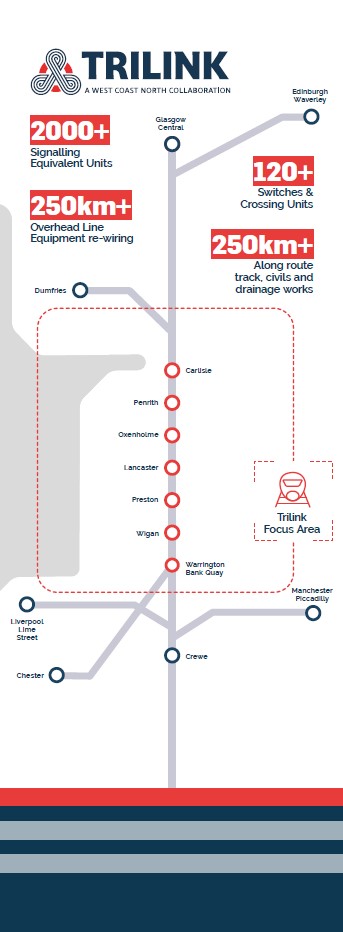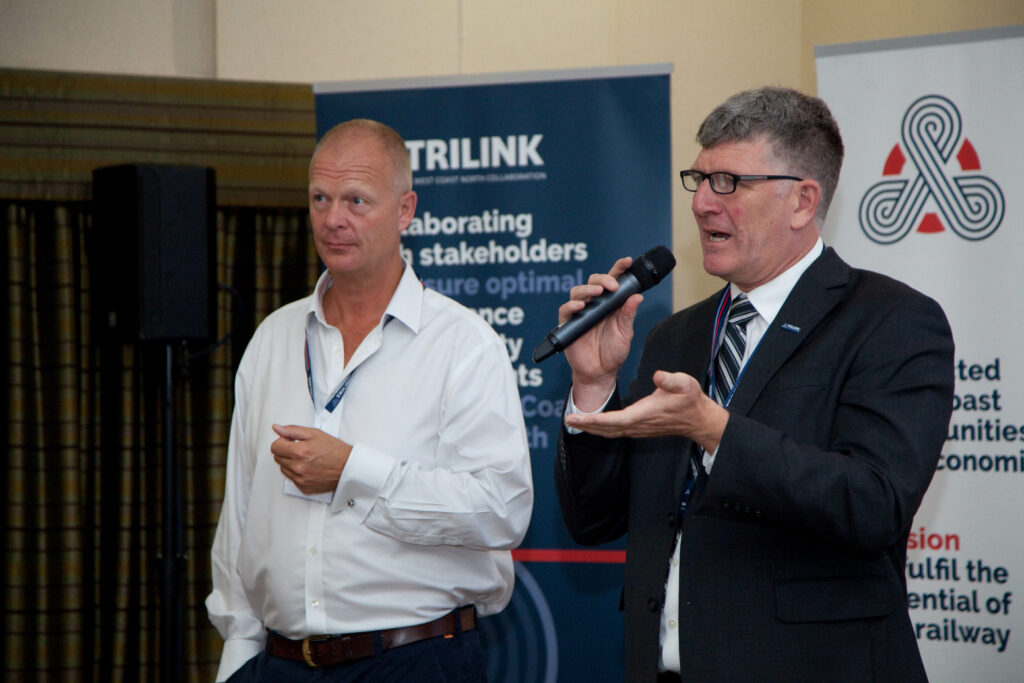The West Coast Main Line (WMCL) is arguably the most important long-distance railway trunk route in Britain. The line was developed in the mid-1800s, to connect London and Glasgow with connections to the cities of Birmingham, Manchester, Liverpool, and Edinburgh. It does not just connect north and south of the country though, as it also serves key towns and cities along the route – and not just for passenger traffic, as the WCML carries a significant amount of freight. The Government has set a target to grow rail freight by at least 75% by 2050 to boost economic growth and deliver environmental benefits by taking lorries off roads.
The route from Preston Brook tunnel south of Warrington to Gretna, located to the north of Carlisle, was last significantly renewed 50 years ago when overhead electrification was provided. Dozens of absolute block mechanical signal boxes with semaphore signalling were also replaced with colour light track circuit signalling, controlled from Warrington, Preston, and Carlisle power signal boxes. Carlisle power signal box alone replaced over 40 mechanical signal boxes.
Now, 50 years later, TriLink is the name of the programme to ‘intelligently’ renew the route and to provide a more reliable timetable for passengers and freight services. The objective is to renew the assets so they are safer, easier to maintain, and more reliable, to keep passengers and freight moving while reducing the volume of costly signalling work.
The WCML of today is a different railway to that of the 1970s. Passenger trains are no longer locomotive hauled, freight trains are longer, and trains have far better acceleration and braking capabilities. European Train Control System (ETCS) is finally being rolled out, which will remove the restrictions of fixed signalling, and provide features such as bidirectional working and with far better train protection.
The route north of Preston is essentially a two-track railway with passing loops, and trains need to be able to leave and join the main line as quickly as possible – something the existing layouts do not facilitate. The loops also need to be long enough to accommodate modern longer intermodal (container) freight trains. So, if loops cannot be extended and made faster, they ideally need to be recovered, subject to the formal network change process.

Intelligent renewal
Rail Engineer was delighted to be invited by Network Rail’s principal programme sponsor, David Gordon, to learn more about the TriLink programme and the intelligent renewal of WCML north.
David explained that the programme involves a scale of investment of multi-discipline renewals that doesn’t often take place. Traditionally, the default approach of a renewals project is to replace an old asset ‘like for like’ with a new and, at best, modern equivalent with the same functionality. These renewals are sponsored and specified by the discipline asset owner and generally there is little scope to improve the overall train network service.
Intelligent renewal takes a more cross functional, pragmatic approach with the objective of finding ways to provide an efficient modern railway, tailored to the needs of the customers. A key element with the development of TriLink and its intelligent renewal objective is to seek a wide, diverse range of views from the network’s customers, and to achieve and maintain a cross-industry, collaborative, industry partnership approach. The TriLink name, for example, represents the Department of Transport, Network Rail as the infrastructure manager, and all the train operators.
The development of the programme looked at the ability to operate the railway far better in the future, balancing freight and passenger services requirements with access for engineering trains, and to provide infrastructure that can be managed and maintained far more efficiently. Renewing all the major assets in a single programme, and intelligently, creates the opportunity to really make a difference and to make carbon friendly rail travel even more appealing.
To do that means looking for areas of the network that can be improved and to create efficiencies, not just for today but also for future generations. The key is to identify how assets can be replaced differently and to maximise the opportunities to rationalise the infrastructure and deliver a more capable railway.
The programme is committed to providing the right things in the right place to allow trains to go at the right speed at the right time, and evaluating the need to renew assets that were designed for a different era.
To some this may sound like enhancement rather than a renewals project, but David explained how the programme has identified how it can deliver better functionality with fewer assets by placing them in the optimum location. Another factor in the intelligent renewal objective is to future proof the changes and to ensure that, so far as reasonably possible, any additional enhancements or changes to the network can be considered and will not be frustrated by the TriLink works.
Cross rail industry communication and collaboration are key. The rail industry has a habit of working in silos and not looking at the bigger picture. A railway is a system of systems, which must all work together seamlessly and like clockwork. TriLink therefore invited a diverse mix of railway people with vast local and industry experience to be involved with the planning of the programme. This included those operating every type of train, the people planning the timetable, and those managing and maintaining every type of asset. The scope of the TriLink renewals is fundamentally track, signalling and telecoms (with ETCS), and overhead line electrification assets. However, there are likely to be track blockades required which will allow other work, such as for structures and station works, to also be undertaken.
Traffic flows
Every part of the TriLink programme has been subject to a ‘clean sheet’ intelligent renewal analysis and proposals drawn up and costed, such as the changes at Warrington.
There are several such locations on the route where currently the traffic flow must cross the WCML from east to west / west to east on flat crossovers. Traffic from Morecombe to Lancaster currently crosses the WCML ‘at grade’ twice within two miles. At one of the project’s optimisation workshops, an operator suggested that the proposed layout could be further improved if the Down Line was made fully bidirectional between Lancaster and Morecombe South Curve alleviating existing timetable constraints. Other similar examples exist elsewhere along the length of the project.
To the north of Preston, the loops will be adjusted and occasionally extended to accommodate long intermodal freight trains. Layout alterations throughout the length of the project will result in a net saving of Signalling Equivalent Units (SEUs). An SEU is defined as a single trackside output function controlled by an interlocking and is a way of simplifying the complexity of signalling so that planning and budgeting can be expressed at a simple common level. In total, the TriLink programme believes it can save over 300 SEUs and provide a better more flexible and cost-effective railway.
Faster ‘turn outs’ in and out of loops is another area which will benefit from intelligent renewal to reduce journey times. Trains normally have to slow down to enter a turnout and loop, whereas they can continue at the same speed on the main track. Turnouts are always a critical point, and they very often condition the speed of trains. There are loops on the route which have an entrance speed of 25mph, a track speed of 20mph, and an exit speed of 10mph. The route is busy, so it’s important that trains can get off and back onto the main line as soon as possible; therefore, TriLink is looking to harmonise loop entry/exit and line speed to typically 50mph if possible.

A major benefit of ETCS is that it is a cost-effective bi-directional signalling system, as no expensive signal structures and signals are required, and intelligent deployment of ETCS and track renewals will allow simpler and more efficient train paths. So, for example, simplified bi-directional working could be deployed for the whole route using pre-existing crossover pairs for planned single line working to allow maintenance activities to take place more easily.
At Carnforth, a potential option subject to enhancement funding could be to provide a cord to allow local trains to access the station via the line to Barrow-in-Furness and return to the WCML to travel north. This would not only provide a passing loop at Carnforth, but also the ability for main line trains to stop at Carnforth station once again.
These are only a few examples of the intelligent renewals that the TriLink programme is planning in order to provide a more efficient railway.
Implementation
A programme of works such as TriLink is likely to require a series of blockades. There are those who may question why Network Rail cannot deliver schemes “like we used to” with fewer ‘no train’ periods. Since the route was last renewed 50 years ago, safety requirements have vastly improved and there are now several items of legislation to manage safety risk. These include The Work at Height Regulations 2005, Electricity at Work Regulations 1989, and The Health and Safety at Work Act 1974; so things cannot be implemented as they once were and the priority has to be ‘Everyone Home Safe Every Day’.
The rail industry wants everyone to get home safely, including colleagues, passengers, suppliers, lineside neighbours, communities, and anyone who lives, works, or goes near a railway.
However, the key to good implementation is to maximise the work content of every ‘no train’ period and manage the work programme efficiently, and to do as much work as possible in the shortest period of time. Customers soon get very upset if a railway is not available and no work is taking place, and, just as important, train diversions and bus replacement services must be very well organised and efficient. The work must also be done properly, so that the railway is not disrupted to the same extent for at least another 50 years.
There are a huge number of factors that could determine where the best location is to start implementing a programme such as TriLink, and these will differ depending on the asset type. However, with ETCS deployment the fixed infrastructure is relatively easy to provide compared to ETCS train fitment, training, route familiarisation, and system configuration (making sure that everything works together). Therefore, when taking ETCS train fitment and training into account, the best place to start will be in the north and in the Carlisle area, with fewer drivers to train, trains to fit, and less system testing compared to other parts of the route.
TriLink legacy
The result of TriLink for the WCML will be a more reliable timetable for passengers, longer freight services to improve economic growth and the environment, and to provide a solution that will be easier to maintain, while reducing the volume of costly signalling and track work.
This ‘intelligent renewal’ approach should be applied to any future route-wide projects, and is very relevant as the ETCS plan moves forward and re-signalling happens nationally over the next 20 years. The overall TriLink programme renewal scope is not-optional for a lot of the assets – they are, or soon will be, life expired so something has to happen. So why not make a better railway, intelligently, at the same time?
Image credit: TriLink

